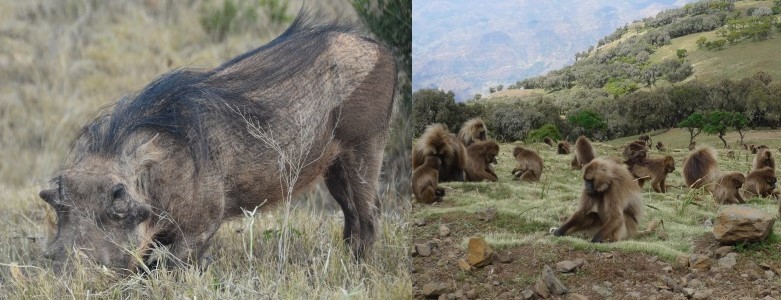Warthogs and baboons are the reserve greenkeepers of the African savannas, maintaining grazing lawns when the ungulate migrations suffer catastrophe.

Prof. Mumblebard says: “Warthogs and baboons squeeze in amongst the grazing bovines, antelopes, zebras, rhinoceros, elephant and rodents of the African savannas by being sparsely-populated omnivores. Warthogs are the pigs most emancipated from thickets and baboons are the most terrestrial of monkeys but they’re largely irrelevant to the plains game. Warthogs and baboons are just incidental players, with minor and peripheral roles. Their hypothetical extinction wouldn’t affect the migratory ungulates.”
Robin and the Honey Badger say: “There’s an overlooked paradox here. Only in Africa are pigs and monkeys – as warthogs and baboons – adapted to graze green lawns, but such omnivores should have had greater scope to graze in Asia and the Americas where there are few ungulates, not the Serengeti where there are many. Resolution = think ‘reserve greenkeepers’. When the grazing migrations collapse from drought, epidemics or overhunting, the grazing lawns risk becoming weed-encroached. This is when warthogs and baboons breed up from reserve numbers and narrow their ancestral omnivory to act as honorary grazers, maintaining desirable grasses by mowing and tilling. Warthogs breed faster than antelopes and so can irrupt until the main grazers repopulate; baboons complement the pigs by destroying the seeds and seedlings of proliferating scrub. Once the true grazers and their predators return, warthogs and baboons become largely redundant and revert to sparsity and omnivory – until the next catastrophe. So, they have a reciprocal relationship with the plains game in maintaining the savanna for all in the long term.”

***
More videos
Featured image
- Left: Warthog grazing by Dariusz Jemielniak (CC BY-SA 4.0, Warthog Grazing)
- Right: Baboons grazing by Alastair Rae (CC BY-SA 2.0, Baboons Grazing)

